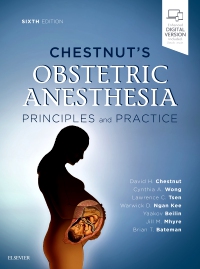
Chestnut's Obstetric Anesthesia: Principles and Practice - Elsevier eBook on VitalSouce, 6th Edition
Elsevier eBook on VitalSource

Now $201.59
**Selected for Doody’s Core Titles® 2024 with "Essential Purchase" designation in Anesthesiology & Pain Medicine**
Comprehensive, user-friendly, and up to date, Chestnut's Obstetric Anesthesia: Principles and Practice, 6th Edition, provides the authoritative clinical information you need to provide optimal care to your patients. This substantially revised edition keeps you current on everything from basic science to anesthesia techniques to complications, including coverage of new research that is paving the way for improved patient outcomes. An expert editorial team ensures that this edition remains a must-have resource for obstetric anesthesiologists and obstetricians, nurse anesthetists and anesthesiology assistants, and anesthesiology and obstetric residents and students.
-
- Presents the latest information on anesthesia techniques for labor and delivery and medical disorders that occur during pregnancy, emphasizing the treatment of the fetus and the mother as separate patients with distinct needs
- Contains new chapters on shared decision-making in obstetric anesthesia and chronic pain during and after pregnancy
- Features extensive revisions from cover to cover, including consolidated information on maternal infection and postoperative analgesia
- Covers key topics such as neonatal assessment and resuscitation, pharmacology during pregnancy and lactation, use of nitrous oxide for labor analgesia, programmed intermittent epidural bolus (PIEB) technique, epidural analgesia-associated fever, the role of gastric ultrasonography to assess the risk of aspiration, sugammadex in obstetric anesthesia, the role of video laryngoscopy and new supraglottic airway devices, spinal dysraphism, and cardiac arrest in obstetric patients
- Incorporates the latest guidelines on congenital heart disease and the management of sepsis, as well as difficult airway guidelines that are specific to obstetric anesthesia practice
- Offers abundant figures, tables, and boxes that illustrate the step-by-step management of a full range of clinical scenarios
-
Part I: Introduction
1. The History of Obstetric Anesthesia
Part II: Maternal and Fetal Physiology
2. Physiologic Changes of Pregnancy
3. Uteroplacental Blood Flow
4. The Placenta: Anatomy, Physiology, and Transfer of Drugs
5. Fetal Physiology
Part III: Fetal and Neonatal Assessment and Therapy
6. Antepartum Fetal Assessment and Therapy
7. Anesthesia for Fetal Surgery and Other Intrauterine Procedures
8. Intrapartum Fetal Assessment and Therapy
9. Neonatal Assessment and Resuscitation
10. Fetal and Neonatal Neurologic Injury
Part IV: Foundations in Obstetric Anesthesia
11. Patient Safety and Team Training
12. Spinal, Epidural, and Caudal Anesthesia: Anatomy, Physiology, and Technique
13. Local Anesthetics and Opioids
Part V: Anesthesia Before and During Pregnancy
14. Pharmacology and Nonanesthetic Drugs During Pregnancy and Lactation
15. In Vitro Fertilization and Other Assisted Reproductive Technology
16. Problems of Early Pregnancy
17. Nonobstetric Surgery during Pregnancy
Part VI: Labor and Vaginal Delivery
18. Obstetric Management of Labor and Vaginal Delivery
19. Trial of Labor and Vaginal Birth after Cesarean Delivery
20. The Pain of Childbirth and its Effect on the Mother and the Fetus
21. Childbirth Preparation and Nonpharmacologic Analgesia
22. Systemic Analgesia: Parenteral and Inhalational Agents
23. Epidural and Spinal Analgesia/ Anesthesia for Labor and Vaginal Delivery
24. Alternative Regional Analgesic Techniques for Labor and Vaginal Delivery
25. Postpartum Tubal Sterilization
Part VII: Cesarean Delivery
26. Anesthesia for Cesarean Delivery
27. Postoperative Analgesia
Part VIII: Anesthetic Complications
28. Aspiration: Risk, Prophylaxis, and Treatment
29. The Difficult Airway: Risk, Assessment, Prophylaxis, and Management
30. Postpartum Headache
31. Neurologic Complications of Pregnancy and Neuraxial Anesthesia
32. Shared Decision-Making in Obstetric Anesthesia
Part IX: Obstetric Complications
33. Preterm Labor and Delivery
34. Abnormal Presentation and Multiple Gestation
35. Hypertensive Disorders
36. Infection
37. Antepartum and Postpartum Hemorrhage
38. Embolic Disorders
39. Maternal Mortality
Part X: The Parturient with Systemic Disease
40. Autoimmune Disorders
41. Cardiovascular Disease
42. Chronic Pain During and After Pregnancy
43. Endocrine Disorders
44. Hematologic and Coagulation Disorders
45. Liver Disease
46. Malignant Hyperthermia
47. Musculoskeletal Disorders
48. Neurologic and Neuromuscular Disease
49. Obesity
50. Psychiatric Disorders
51. Renal Disease
52. Respiratory Disease
53. Substance Abuse
54. Trauma and Critical Care
Appendices
A: American Society of Anesthesiologist Guidelines for Neuraxial Anesthesia in Obstetrics
B: Practice Guidelines for Obstetric Anesthesia: An updated report by The American Society of Anesthesiologists Task Force on Obstetric Anesthesia and the Society for Obstetric Anesthesia and Perinatology
C: Optimal Goals for Anesthesia Care in Obstetrics
D: Information Technology Resources for Obstetric Anesthesia Providers

 as described in our
as described in our 